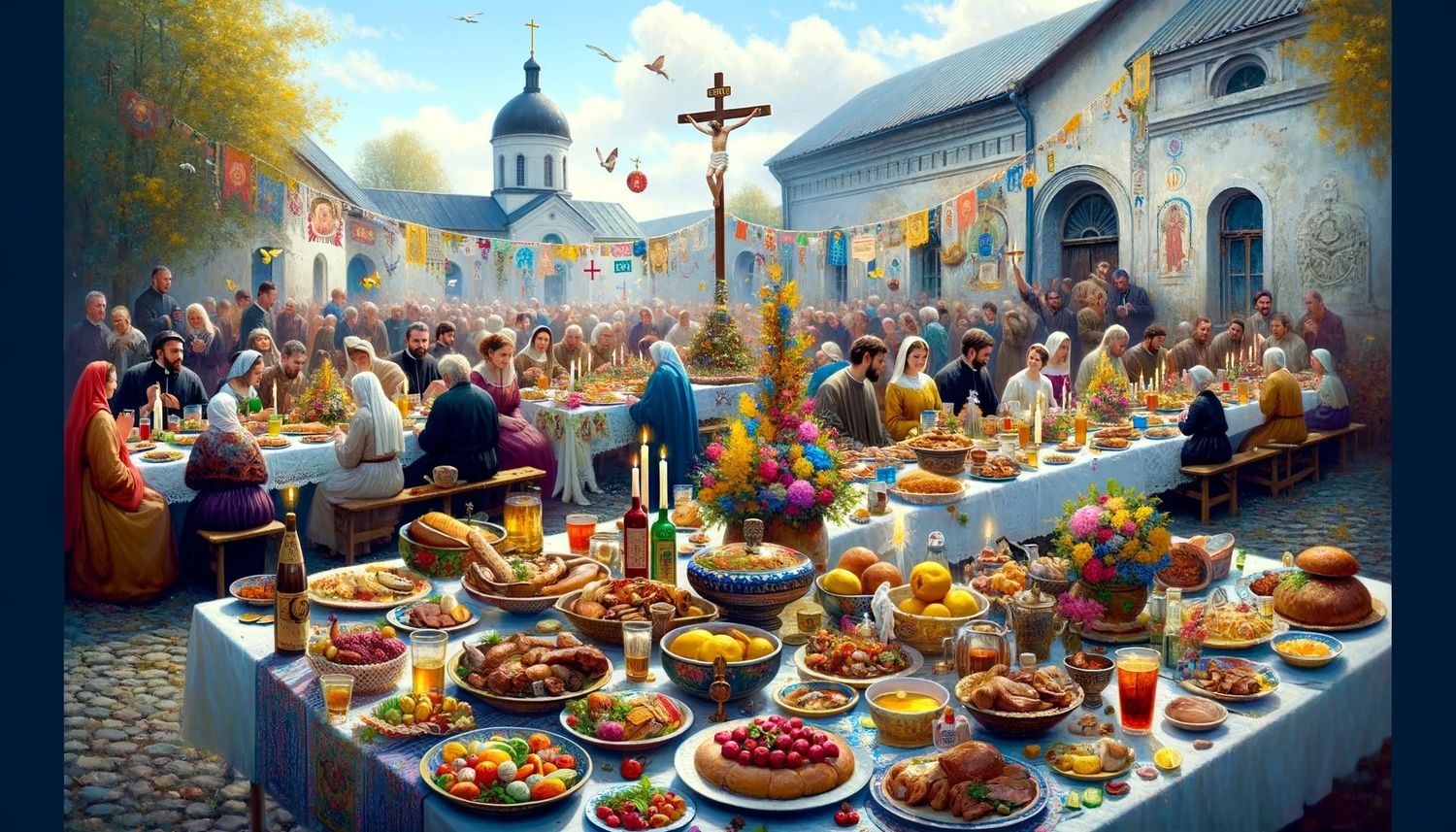Home>Theology and Spirituality>What Foods Are Forbidden In Catholicism


Theology and Spirituality
What Foods Are Forbidden In Catholicism
Published: February 15, 2024
Ericka Andersen, an editor at Christian.net, expertly merges digital strategy with content creation, focusing on faith and societal issues. Her communication skills enhance the platform's engaging narratives, fostering meaningful dialogue on belief's impact on society.
Discover the forbidden foods in Catholicism and explore the theological and spiritual significance behind dietary restrictions. Uncover the religious beliefs that shape dietary practices.
(Many of the links in this article redirect to a specific reviewed product. Your purchase of these products through affiliate links helps to generate commission for Christian.net, at no extra cost. Learn more)
Table of Contents
Introduction
Catholicism, with its rich tapestry of traditions and practices, encompasses various guidelines and restrictions related to food consumption. The concept of forbidden foods in Catholicism is deeply rooted in religious teachings and has evolved over centuries, shaping the dietary habits of devout followers. Understanding the significance of these dietary restrictions provides valuable insight into the spiritual and cultural dimensions of the faith.
The interplay between food and spirituality has been a fundamental aspect of religious traditions across the world, and Catholicism is no exception. The rules and traditions surrounding forbidden foods in Catholicism are not merely about dietary restrictions; they are symbolic of deeper spiritual principles and serve as a means of fostering discipline, self-reflection, and reverence for religious observances.
Exploring the nuances of forbidden foods in Catholicism unveils a multifaceted tapestry of beliefs, rituals, and historical contexts. From the observance of meatless Fridays to the solemn period of Lent, the dietary guidelines in Catholicism are intertwined with the rhythm of the liturgical calendar, offering a unique lens through which to comprehend the faith's holistic approach to spirituality.
As we delve into the intricacies of forbidden foods in Catholicism, it becomes evident that these restrictions are not arbitrary; rather, they are imbued with profound symbolism and spiritual significance. By examining the historical and theological underpinnings of these dietary practices, we gain a deeper appreciation for the role of food in shaping the religious identity and practices of Catholic adherents.
The Concept of Forbidden Foods in Catholicism
The concept of forbidden foods in Catholicism is deeply intertwined with the religious and cultural fabric of the faith. Rooted in centuries-old traditions and theological principles, these dietary restrictions hold profound significance for devout Catholics. At the core of this concept lies the idea of sacrifice, discipline, and spiritual mindfulness.
Central to the understanding of forbidden foods in Catholicism is the notion of abstinence and fasting. These practices are not merely about refraining from specific foods; rather, they serve as a means of spiritual discipline and self-denial. By voluntarily abstaining from certain foods, Catholics seek to emulate the sacrifices made by Jesus Christ and to cultivate a deeper sense of empathy and solidarity with those who are less fortunate.
Furthermore, the concept of forbidden foods in Catholicism is intricately linked to the liturgical calendar, which delineates various periods of feasting and fasting throughout the year. For example, the observance of Lent, a solemn period of 40 days leading up to Easter, involves specific dietary restrictions that symbolize the spiritual journey of repentance and renewal. During Lent, Catholics are called to abstain from meat on Ash Wednesday and all Fridays, underscoring the significance of self-discipline and spiritual reflection.
Moreover, the concept of forbidden foods in Catholicism underscores the interconnectedness of the spiritual and the physical. It serves as a reminder that the act of eating is not merely a mundane activity but a sacred practice that carries profound symbolic weight. By adhering to these dietary restrictions, Catholics are reminded of their commitment to living a life that is aligned with their religious values and principles.
In essence, the concept of forbidden foods in Catholicism transcends mere dietary regulations; it is a tangible expression of faith, a means of embodying spiritual values through everyday actions. By embracing these restrictions, Catholics partake in a tradition that has endured for centuries, connecting them to the rich tapestry of their religious heritage and fostering a deeper sense of spiritual awareness and devotion.
Meat on Fridays
In Catholic tradition, the practice of abstaining from meat on Fridays holds profound significance, rooted in centuries-old religious observances. This venerable custom traces its origins to the early days of the Church and continues to be upheld as a solemn reminder of the sacrificial nature of the faith.
The tradition of refraining from meat on Fridays is deeply intertwined with the commemoration of Christ's crucifixion, which took place on a Friday. By voluntarily abstaining from meat on this day, Catholics honor the ultimate sacrifice made by Jesus Christ for the redemption of humanity. This act of abstinence serves as a tangible expression of solidarity with Christ's suffering and a means of participating in the spiritual journey of self-denial and reflection.
The significance of abstaining from meat on Fridays extends beyond the historical commemoration of Christ's crucifixion. It serves as a continual reminder of the call to embrace self-discipline and spiritual mindfulness in everyday life. By forgoing meat, a staple of many diets, Catholics are prompted to engage in acts of sacrifice and to cultivate a heightened awareness of their spiritual commitments.
Moreover, the tradition of abstaining from meat on Fridays underscores the communal aspect of the Catholic faith. By collectively observing this practice, Catholics worldwide are united in their shared commitment to upholding religious traditions and fostering a sense of solidarity within the faith community. This communal observance serves to reinforce the bonds of fellowship and shared devotion among believers.
The significance of abstaining from meat on Fridays is not confined to a mere dietary restriction; rather, it is a tangible expression of faith that permeates the daily lives of Catholics. Through this practice, believers are reminded of the enduring values of sacrifice, compassion, and spiritual discipline that lie at the heart of their religious identity.
In essence, the tradition of refraining from meat on Fridays serves as a poignant reminder of the sacrificial nature of the Catholic faith, inviting believers to embody the spirit of self-denial and spiritual reflection in their daily lives. This venerable custom continues to resonate as a timeless symbol of devotion and solidarity within the rich tapestry of Catholic tradition.
Fasting and Abstinence
Fasting and abstinence are integral components of the Catholic tradition, embodying the spiritual disciplines of self-denial and moderation. These practices hold profound significance within the liturgical calendar and serve as tangible expressions of devotion and reverence for the faith.
Fasting, in the context of Catholicism, involves the voluntary restriction of food intake, often accompanied by prayer and reflection. This practice is observed on Ash Wednesday and Good Friday, marking the beginning and culmination of the Lenten season. By engaging in fasting, Catholics symbolically align themselves with the forty days that Jesus spent in the wilderness, demonstrating a commitment to spiritual discipline and self-restraint.
Abstinence, on the other hand, pertains to refraining from consuming specific types of food, with the most notable being the abstinence from meat on Ash Wednesday and all Fridays during Lent. This practice serves as a visible reminder of the call to emulate Christ's sacrifice and to cultivate a spirit of solidarity with those who endure hardship and deprivation.
The intertwining of fasting and abstinence within the Catholic tradition underscores the holistic approach to spiritual nourishment. By voluntarily embracing these practices, believers are invited to transcend the material aspects of sustenance and to engage in a deeper communion with their faith. The act of fasting and abstinence becomes a tangible expression of the spiritual journey, fostering introspection, humility, and a renewed sense of devotion.
Furthermore, fasting and abstinence in Catholicism emphasize the interconnectedness of the physical and the spiritual. By moderating their consumption and abstaining from certain foods, believers are reminded of the transient nature of earthly desires and the enduring significance of spiritual nourishment. These practices serve as a means of realigning priorities, redirecting focus towards the pursuit of spiritual fulfillment and the cultivation of empathy for those in need.
In essence, fasting and abstinence stand as enduring pillars of the Catholic faith, embodying the timeless values of self-discipline, spiritual reflection, and communal solidarity. Through these practices, believers partake in a tradition that transcends generations, fostering a profound connection to the rich tapestry of their religious heritage and nurturing a deeper sense of spiritual awareness and devotion.
Specific Forbidden Foods during Lent
During the solemn period of Lent, Catholics adhere to specific dietary restrictions that symbolize the spiritual journey of repentance and renewal. These restrictions, deeply rooted in centuries-old traditions, serve as tangible expressions of devotion and self-discipline, shaping the culinary landscape of the faithful during this sacred season.
One of the most notable dietary restrictions during Lent is the abstinence from meat on Ash Wednesday and all Fridays throughout the season. This practice harkens back to the early days of the Church and holds profound significance in the commemoration of Christ's sacrifice. By refraining from consuming meat, Catholics honor the sacrificial nature of Christ's crucifixion and participate in the spiritual discipline of self-denial and reflection.
In addition to abstaining from meat, Catholics also observe the tradition of forgoing indulgent or rich foods during Lent. This practice underscores the call to embrace simplicity and moderation, redirecting focus towards spiritual nourishment and away from earthly desires. By eschewing lavish or extravagant meals, believers embody the values of humility and self-restraint, aligning their dietary choices with the solemnity of the Lenten season.
Moreover, the tradition of fasting on Ash Wednesday and Good Friday further delineates the specific dietary practices during Lent. By voluntarily restricting food intake and engaging in prayer and reflection, Catholics symbolically align themselves with the forty days that Jesus spent in the wilderness, demonstrating a commitment to spiritual discipline and self-restraint.
The observance of Lenten dietary restrictions extends beyond mere culinary choices; it is a tangible expression of faith that permeates the daily lives of Catholics. Through these practices, believers are reminded of the enduring values of sacrifice, compassion, and spiritual discipline that lie at the heart of their religious identity.
In essence, the specific forbidden foods during Lent serve as poignant reminders of the sacrificial nature of the Catholic faith, inviting believers to embody the spirit of self-denial and spiritual reflection in their daily lives. These venerable customs continue to resonate as timeless symbols of devotion and solidarity within the rich tapestry of Catholic tradition.
Read more: What Is Catholicism?
The Role of Forbidden Foods in Catholicism Today
The role of forbidden foods in Catholicism today extends far beyond mere dietary restrictions; it encompasses a multifaceted tapestry of spiritual, cultural, and communal significance. In the contemporary context, the observance of forbidden foods serves as a tangible expression of faith, fostering a deeper sense of spiritual awareness and communal solidarity among believers.
One of the pivotal roles of forbidden foods in Catholicism today is the preservation of tradition and heritage. The adherence to dietary restrictions, such as abstaining from meat on Fridays and observing specific dietary practices during Lent, serves as a means of connecting present-day believers to the rich tapestry of their religious heritage. By upholding these venerable customs, Catholics partake in a tradition that has endured for centuries, fostering a profound connection to the timeless values and principles of their faith.
Furthermore, the observance of forbidden foods in Catholicism today serves as a catalyst for communal solidarity and shared devotion. The collective adherence to dietary restrictions creates a sense of unity and fellowship within the faith community, reinforcing the bonds of shared commitment and spiritual discipline. This communal observance transcends geographical boundaries, uniting Catholics worldwide in their dedication to upholding religious traditions and fostering a sense of solidarity within the global faith community.
Moreover, the role of forbidden foods in Catholicism today underscores the enduring values of sacrifice, self-discipline, and spiritual mindfulness. By embracing these dietary restrictions, believers are reminded of their commitment to living a life that is aligned with their religious values and principles. The act of abstaining from forbidden foods becomes a tangible expression of faith, permeating the daily lives of Catholics and fostering a deeper sense of spiritual awareness and devotion.
In essence, the role of forbidden foods in Catholicism today encompasses a rich tapestry of tradition, communal solidarity, and spiritual devotion. By upholding these dietary restrictions, believers partake in a practice that transcends generations, connecting them to the enduring values and principles of their religious heritage. The observance of forbidden foods serves as a timeless symbol of devotion and solidarity within the rich tapestry of Catholic tradition, shaping the spiritual and cultural identity of believers in the contemporary era.
Conclusion
In conclusion, the concept of forbidden foods in Catholicism embodies a profound tapestry of tradition, spirituality, and communal solidarity. From the observance of meatless Fridays to the solemn period of Lent, these dietary restrictions are not merely about culinary limitations; they are symbolic of deeper spiritual principles and serve as a means of fostering discipline, self-reflection, and reverence for religious observances.
The interplay between food and spirituality within the Catholic tradition underscores the enduring values of sacrifice, self-discipline, and communal solidarity. The observance of forbidden foods serves as a tangible expression of faith, permeating the daily lives of believers and fostering a deeper sense of spiritual awareness and devotion.
Furthermore, the role of forbidden foods in Catholicism today extends beyond mere dietary restrictions; it encompasses the preservation of tradition and heritage. By upholding these venerable customs, Catholics partake in a tradition that has endured for centuries, fostering a profound connection to the timeless values and principles of their faith.
The observance of forbidden foods also serves as a catalyst for communal solidarity and shared devotion. The collective adherence to dietary restrictions creates a sense of unity and fellowship within the faith community, reinforcing the bonds of shared commitment and spiritual discipline.
In essence, the concept of forbidden foods in Catholicism is a testament to the enduring legacy of the faith, shaping the spiritual and cultural identity of believers across generations. By embracing these dietary restrictions, Catholics partake in a practice that transcends time, connecting them to the rich tapestry of their religious heritage and fostering a deeper sense of spiritual awareness and devotion.














